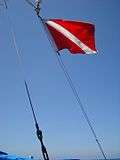Diver down flag


A diver down flag, or scuba flag, is a flag used on the water to indicate that there is a diver below. Two styles of flag are in use. Internationally, the code flag alfa/alpha, which is white and blue, is used to signal that the vessel has a diver down and other vessels should keep well clear at slow speed. In North America it is conventionally red with a white stripe from the upper left corner to the lower right corner.
Purpose
The purpose of the flags is to notify to any other boats to steer clear for the safety of the diver and to avert the possibility of a collision with the dive boat which may be unable to maneuver out of the way.
Signal flag Alpha

As a code signal the International maritime signal flag Alpha (or "Alfa", signifying the letter "A") has the meaning of "I have a diver down; keep well clear at slow speed",[1] used to indicate the presence of a diver in the water and is used in all countries other than the United States of America, Canada, sometimes Italy, and countries within the US's diving culture sphere of influence such as certain countries within the Caribbean.
A rigid replica of the 'Alpha' flag is required to be displayed by any vessel engaged in diving operations, when restricted in her ability to maneuver, if the size of the vessel makes it impractical to display the shapes and lights required by the International Regulations for Preventing Collisions at Sea (IRPCS) Rule 27.[2][3]
Although the presence of the 'A' flag may afford some protection for divers in the vicinity of the vessel displaying the flag, the intention of the rigid replica required by IRPCS Rule 27 (e) is to warn other vessels of the danger of collision. This marks a distinction between the 'Alpha' flag and the red and white diver down flag.[4]
The red and white flag

The use of the red and white flag, which was created in 1956 by Navy veteran Denzel James Dockery and popularised by Ted Nixon of US Divers,[5][6] is required by law or regulation in many US states, Canada,[7] and some other countries (e.g. Italy).[8] Usually the regulations require divers to display the flag while diving and to stay within a specified distance of it when they are near the surface. There may also be a larger zone around the flag where no boats are allowed to pass. Some states also prohibit the display of this flag when there is no diver in water. It can be placed on a boat or on a surface marker buoy.
Other uses
Today the red and white flag is so strictly associated with scuba diving in North America that it is also used to indicate a place where there are services for divers, for example stores selling or renting diving equipment or scuba service stations. It may be seen on the windows or bumpers of cars belonging to divers.
Code flag alfa/alpha also represents the letter 'A' in signalling.
Rock band Van Halen used the red and white flag as the cover art of their 1982 album Diver Down.
The webcomic Alpha Flag[9] features both the American and International variant of the diver down flag among other signal flags as part of its plot device.
Notes
- ↑ "U.S. Navy Signal Flags". United States Navy. 17 August 2009. Retrieved 11 April 2016.
- ↑ "Rule 27: Vessel not under command". U.S. Coast Guard Navigation Center. Retrieved 1 February 2010.
- ↑ "IRPCS Rule 27". Retrieved 1 February 2010.
- ↑ "Eighth Coast Guard District Special Notice to Mariners" (PDF). United States Coast Guard. 2008. p. 23. Retrieved 2 February 2010.
The distinction the Coast Guard wants to make clear is: The Alpha flag is a navigational signal intended to protect the vessel from collision. The sports diver flag is an unofficial signal that, through custom, has come to be used to protect the diver in the water.
- ↑ Cronje, Frans J (2007). "An Historic Overview of Recreational Scuba Diving.". In: Moon RE, Piantadosi CA, Camporesi EM (eds.). Dr. Peter Bennett Symposium Proceedings. Held May 1, 2004. Durham, N.C.:. Divers Alert Network: 6. Retrieved 2011-01-13.
- ↑ Richardson, Drew (1999). "A brief history of recreational diving in the United States.". South Pacific Underwater Medicine Society Journal. 29 (3). Retrieved 2011-01-13.
- ↑ McMillan, Joseph (2001). "Maritime Warning Signals". Sea Flags. Retrieved 1 February 2010.
- ↑ "Italian regulations about the Diver Down Flag". D.P.R. n° 1639 del 2 ottobre 1968 (in Italian). Retrieved 1 February 2010.
- ↑ Alpha Flag Archived 2013-07-22 at the Wayback Machine.
External links
| Wikimedia Commons has media related to Diver down flag. |
- "Nautical flag history". Retrieved 18 November 2016.
- "US diver down flag history". Archived from the original on 5 May 2008.
- Wallbank, Alister (2001). "Can anybody see me? (modified reprint from DIVER 2000; 45 (2) February: 72-74)". Journal of the South Pacific Underwater Medicine Society. 31 (2): 116–119. Retrieved 13 October 2008.
- Whitten, Chris (2010). "Dive Flag Law: Rules for U.S. divers and boaters". Retrieved 18 November 2016. - Collection of US regulations for each state.
